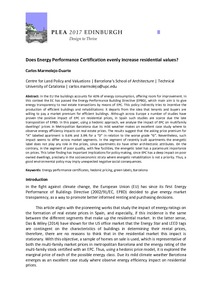Mostra el registre d'ítem simple
Does energy performance certification evenly increase residential values?
| dc.contributor.author | Marmolejo Duarte, Carlos Ramiro |
| dc.contributor.other | Universitat Politècnica de Catalunya. Departament de Tecnologia de l'Arquitectura |
| dc.date.accessioned | 2018-03-01T17:43:12Z |
| dc.date.available | 2018-03-01T17:43:12Z |
| dc.date.issued | 2017 |
| dc.identifier.citation | Marmolejo, C. Does energy performance certification evenly increase residential values?. A: International Conference on Passive and Low Energy Architecture. "PLEA International Conference, Design to Thrive, Edinburgh, 2th-5th July 2017". London: Network for Comfort and Energy Use in Buildings, 2017, p. 2602-2609. |
| dc.identifier.isbn | 978-0-9928957-5-4 |
| dc.identifier.uri | http://hdl.handle.net/2117/114709 |
| dc.description.abstract | In the EU the buildings accounts for 40% of energy consumption, offering room for improvement. In this context the EC has passed the Energy Performance Building Directive (EPBD), which main aim is to give energy transparency to real estate transactions by means of EPC. This policy indirectly tries to incentive the production of efficient buildings and rehabilitations: it departs from the idea that tenants and buyers are willing to pay a market premium for efficient buildings. Although across Europe a number of studies have proven the positive impact of EPC on residential prices, in Spain such studies are scarce due the late transposition of EPBD. In this paper, using a hedonic approach, we analyse the impact of EPC on multifamily dwellings’ prices in Metropolitan Barcelona due its mild weather makes an excellent case study where to observe energy efficiency impacts on real estate prices. The results suggest that the asking price premium for “A” labelled apartment is 9.6% and 3.9% for a “D” in relation to the worse grade “G”. Nevertheless, such impact seems to differ across market segments. In the segment of recently built apartments the energetic label does not play any role in the prices, since apartments do have other architectonic attributes. On the contrary, in the segment of poor quality, with few facilities, the energetic label has a paramount importance on prices. This latter finding has important implications for policy making, since EPC has a deep impact on poor owned dwellings, precisely in the socioeconomic strata where energetic rehabilitation is not a priority. Thus, a good environmental policy may imply unexpected negative social consequences. |
| dc.format.extent | 8 p. |
| dc.language.iso | eng |
| dc.publisher | Network for Comfort and Energy Use in Buildings |
| dc.rights | Attribution-NonCommercial-NoDerivs 3.0 Spain |
| dc.rights.uri | http://creativecommons.org/licenses/by-nc-nd/3.0/es/ |
| dc.subject | Àrees temàtiques de la UPC::Arquitectura::Aspectes econòmics |
| dc.subject | Àrees temàtiques de la UPC::Urbanisme::Aspectes econòmics |
| dc.subject | Àrees temàtiques de la UPC::Energies::Eficiència energètica |
| dc.subject.lcsh | Real property -- Spain -- Barcelona |
| dc.subject.lcsh | Dwellings--Energy consumption -- Spain -- Barcelona |
| dc.subject.other | Energy performance certificates |
| dc.subject.other | Hedonic pricing |
| dc.subject.other | Green labels |
| dc.subject.other | Barcelona |
| dc.title | Does energy performance certification evenly increase residential values? |
| dc.type | Conference report |
| dc.subject.lemac | Béns immobles -- Catalunya -- Barcelona |
| dc.subject.lemac | Habitatges -- Consum d'energia -- Catalunya -- Barcelona |
| dc.contributor.group | Universitat Politècnica de Catalunya. CPSV - Centre de Política de Sòl i Valoracions |
| dc.rights.access | Open Access |
| local.identifier.drac | 21987622 |
| dc.description.version | Postprint (published version) |
| local.citation.author | Marmolejo, C. |
| local.citation.contributor | International Conference on Passive and Low Energy Architecture |
| local.citation.pubplace | London |
| local.citation.publicationName | PLEA International Conference, Design to Thrive, Edinburgh, 2th-5th July 2017 |
| local.citation.startingPage | 2602 |
| local.citation.endingPage | 2609 |


